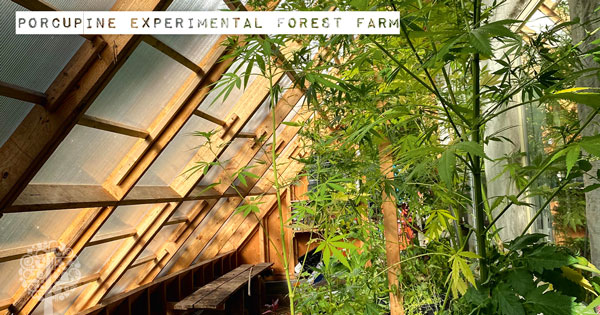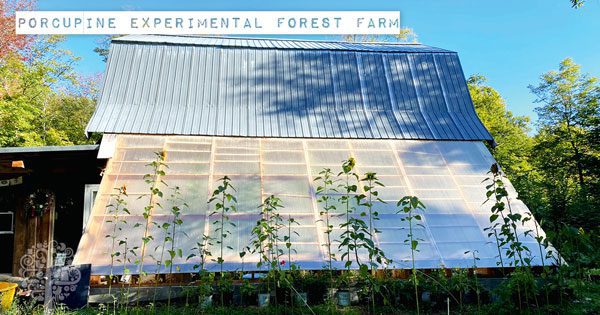When you step onto Porcupine Experimental Forest Farm in Wentworth-North, Quebec, it’s hard to believe it was once a vacant lot of compacted gravel. Surrounded by a forest of green, the property now boasts lush gardens of fruits, vegetables, and spectacular flowers. It is very much alive with the sounds of ducks, chickens, and a super vocal rooster. For Heather Jackson and Regan Moran, the homestead they’ve created together truly has been a labor of love.
Building From The Ground Up
Regan purchased the property in 2011, and since then, has built a house with an attached greenhouse. With no soil to speak of, he and Heather diligently and patiently made their gardens by hand.
“We brought in a lot of stuff,” Heather explains. “In the fall, we collected paper bags full of leaves that people left on the side of the road. We would fill the back of the truck and bring them back here and spread them; do a true lasagna garden with the leaves, the cardboard, the mulch, grass clippings, weeds, whatever we could get our hands on to build soil.”
Their hard work has more than paid off. They grow squash, pumpkins, tomatoes, berries, brussels sprouts, kale, gooseberries, nut trees, and more on a quarter of an acre. Regan has a license to grow medical cannabis; four different varieties can be found throughout the garden and greenhouse.

Beyond years of backbreaking work, what’s their secret? They say the answer is always in the soil and that “building” it never stops.
“We are really about farming the dirt,” Heather says. “That’s the first thing we start with, and then everything else falls into place. Feed the soil. The microbes and mycorrhizae; keep building that layer, and everything else happens.”
Always All-Natural
Comfrey is a mainstay on Porcupine Experimental Forest Farm. It grows abundantly on the property and is continuously chopped and mulched, leaching nutrients into the ground as it decomposes.
Heather and Regan never use chemical fertilizers or pesticides on the property and are major proponents of Korean Natural Farming, an effective growing technique that requires only sugar and a few gifts from Nature.
“You’re feeding plants with plants,” Heather explains. “I don’t have to question the source. I know it’s from right here. Like witchcraft, you get to see things fermenting. You’re more participatory in the process.”
As a result, the plants growing on the farm are more resilient to pests and diseases. The slug population has been controlled thanks to the ducks that roam freely through the rows.
Flower Power
Growing flowers is Heather’s true passion. Working with the Laurentian mountains’ seasons, she tends to tulips and daffodils in the fall, sunflowers, zinnias, and solidago in the summer, and chrysanthemums in the fall.
Native plants are her mainstay, but she also experiments with vines like hops and kiwis and includes many medicinal plants in her bouquets that she sells to the local community and a nearby floral shop.

“They attract all kinds of pollinators, and they also help build soil,” Heather says of her cut flowers. “They’re a great companion for the fruits and vegetables, and they’re beautiful as well. Who doesn’t want beautiful things?”
Medicinal Weeds and Permaculture
“We eat a lot of weeds,” Regan tells me as he walks through the garden.
From stinging nettle, dandelions, and wormwood to goldenrod and turkey tail mushrooms, Regan has done years of research and understands the many benefits these things offer to human health.
The best part? All of the medicinal weeds and mushrooms grow naturally on the property, which thrives thanks to the couple’s holistic approach to growing and Regan’s interest in permaculture principles.

Regan was first introduced to permaculture while traveling Australia; he’s been hooked ever since and has taken it upon himself to learn as much as he can about the sustainable way of growing.
“Since then (Australia), we have built a massive library, I’ve done online workshops, and reading and researching, and I’m just letting it all sink in,” he says. “I still have tons to learn, but you have to trust your intuition.”
Sound advice for anyone just starting; research and education are crucial to a successful and thriving garden.
Baby Steps
Heather agrees and understands that gardening can be overwhelming for beginners or those who don’t have a lot of space or time.
“Start really small,” she suggests. “Start with the things you know you like. If you don’t eat eggplant or tomatoes, don’t grow them. Stick with the things you like, and if you end up with a lot of it, take the next step and learn how to preserve them.”
As your garden grows, so will your confidence. Expand from there. Heather recommends nurturing your plants as you would a baby.
“Be present from the very beginning to the end in the lifecycle of the plant. Germinate your seeds, grow your seeds, harvest the fruit and the seed, and then close the loop.”
Plans for the Future
After nine years of devotion to the homestead, Heather is taking some time to reset and travel to other parts of Quebec. But life above and below ground goes on at Porcupine Experimental Forest Farm.
Regan’s property plans include massive raised beds once the snow melts, and eventually, a pasture for sheep, goats, and a dairy cow. Maybe even one day, he’ll be able to go completely off-grid.
Learn more about the farm: homesteadnomads.com